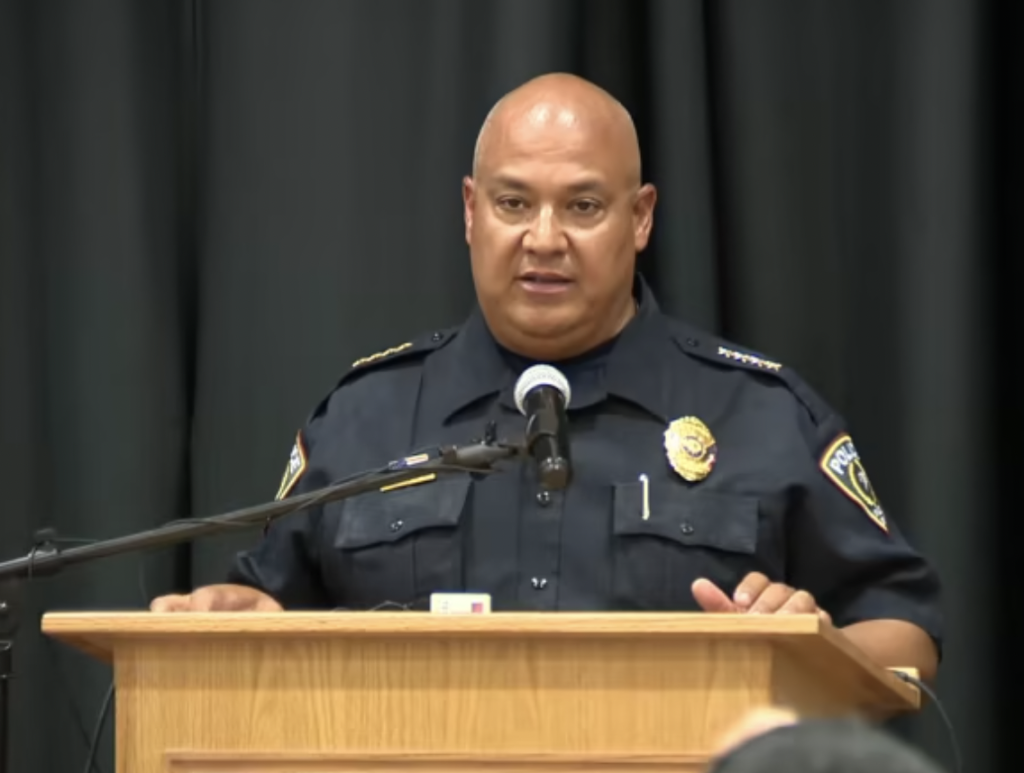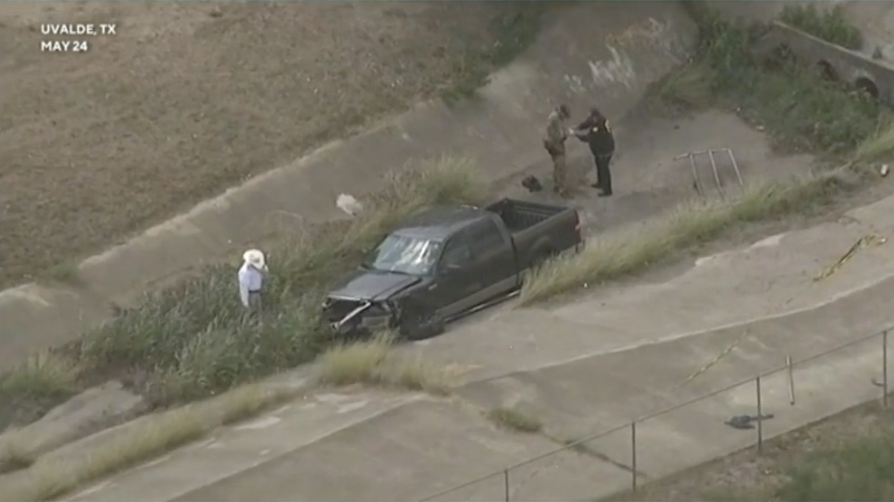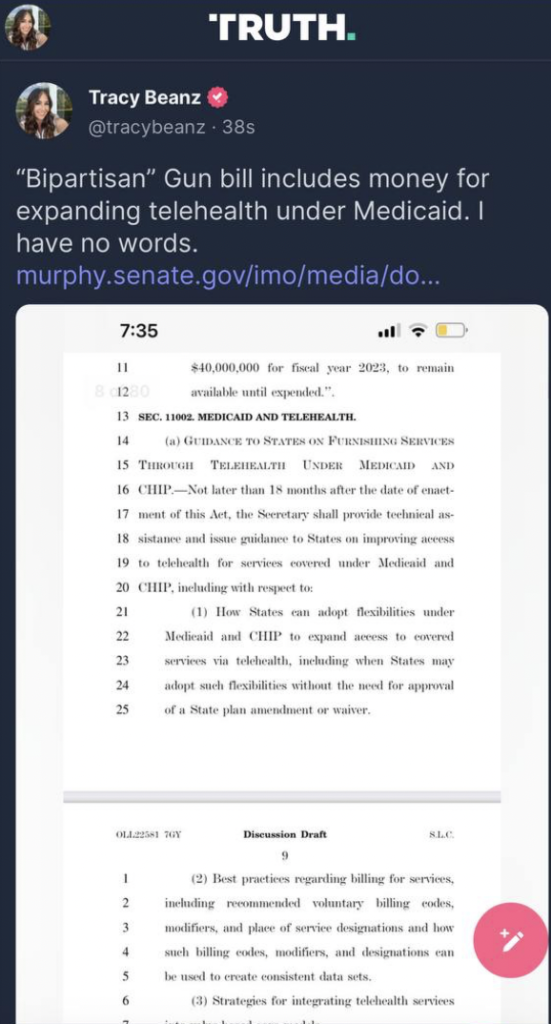The police response to the May 24 Uvalde school shooting was an "abject failure," said Texas Department of Public Safety (DPS) Director Steven McCraw in the first of a two-day hearing before the Texas Senate Special Committee. On June 21, McCraw asserted that within "three minutes," there was a "sufficient number of officers" and equipment on hand to "isolate, distract, and neutralize the subject."
Based on security footage, video and audio recording, and a timeline of events, McCraw lamented, "The only thing stopping a hallway of dedicated officers from entering rooms 111 and 112 was the on-scene commander—," District Police Chief Pete Arredondo,
who decided to place the lives of officers before the lives of children." 19 children and two teachers died in the "senseless massacre," said McCraw. Multiple agencies are now cooperating in the investigation. McCraw continued:
"One hour, 14 minutes, and eight seconds. That's how long the children waited, and the teachers waited in rooms 111 and 112 to be rescued. And while they waited, the on-scene commander waited for radios and rifles. Then he waited for shields. Then he waited for SWAT.
Lastly, he waited for [a] key that was never needed. Officers had weapons. Children had none. The officers had body armor. The children had none. The officers had training. The subject had none."
 Uvalde Police Chief Arredondo/https://www.ksat.com/news/local/2022/06/21/takeaways-from-texas-dps-directors-testimony-about-the-uvalde-shooting-gunman-and-police-response/
Uvalde Police Chief Arredondo/https://www.ksat.com/news/local/2022/06/21/takeaways-from-texas-dps-directors-testimony-about-the-uvalde-shooting-gunman-and-police-response/
The teachers, on the other hand, "quickly implemented active shooter protocols prior to the subject gaining entry." One teacher even called 911 before the subject entered the campus. As a result, hundreds of children were evacuated in "a safe and early manner."
According to the timeline provided in the hearing, the time from police entry to "final termination" was 1 hour, 14 minutes, and 8 seconds. McCraw testified that there was no need for the police to wait for a key, a SWAT team, shields, or rifles to stop the shooter.
"One officer is enough. The post-Columbine doctrine is clear and compelling, and unambiguous. Stop the killing, stop the dying. You can't do the latter unless you do the former." Waiting to engage "was antithetical to everything we've learned over the last two decades since the Columbine massacre. There was a sufficient number of armed officers wearing body armor to isolate, distract and neutralize the subject."
Numerous "systemic" failures resulted in tragedy for 21 souls that day. Classroom doors were not locked, and officers on the scene allegedly failed even to check the doors. Nevertheless, eight minutes after 18-year-old Salvador Ramos entered Robb Elementary school, police said they possessed a crowbar that could have been used to break down the classroom doors. Ramos also entered the building through an unlocked door.
McCraw explained that a teacher had propped the door open with a brick but then later closed the door. He reported that the only way the teacher would have known the door was not locked would have been for her to close the door and then go around to test it from the outside. The same teacher also saw Ramos wreck his grandmother's car in a cement ditch near the school.
 Ramos vehicle in cement ditch/footage from https://www.cbsnews.com/news/uvalde-shooting-more-ammunition-than-us-soldiers-carry-rounds-into-combat/
Ramos vehicle in cement ditch/footage from https://www.cbsnews.com/news/uvalde-shooting-more-ammunition-than-us-soldiers-carry-rounds-into-combat/
Several from a nearby funeral home heard the crash and ran to the ditch where Ramos shot at and missed three people. Don Flanary, the counsel representing the teacher, told San Antonio Express-News.
"She saw the wreck. She ran back inside to get her phone to report the accident. She came back out while on the phone with 911. The men at the funeral home yelled, 'He has a gun!' She saw him jump the fence, and he had a gun, so she ran back inside.
She kicked the rock away when she went back in. She remembers pulling the door closed while telling 911 that he was shooting. She thought the door would lock because that door is always supposed to be locked."
Communication issues also plagued the disastrous response, including the need to use cell phones because the police chief reportedly had no radio to communicate with other officers. Arredondo, who has now testified to the Texas House on Tuesday in a private hearing, stated that his radios "would have slowed him down" and "he knew from experience that the radios did not work in some school buildings," according to reporting from Newsweek. Sergeant Betsy Smith of the National Police Association called Arredondo's decision to leave his radio behind 'unthinkable.'" Smith told Newsweek:
"Cellphones are good for speaking to one person, like a dispatcher or maybe one other officer. In an active shooter situation with multiple agencies responding, everyone needs to be able to talk to each other.
He had 19 people in that hallway and [Arredondo's] the incident commander and can't communicate with them? That is a horrible error. Communication in a situation like this is critical."
Arredondo has stated the accusations that he and the other officers mismanaged the situation are unfair.
"Not a single responding officer ever hesitated, even for a moment, to put themselves at risk to save the children. We responded to the information that we had and had to adjust to whatever we faced. Our objective was to save as many lives as we could, and the extraction of the students from the classrooms by all that were involved saved over 500 of our Uvalde students and teachers before we gained access to the shooter and eliminated the threat."
Ramos Communicated His Intentions Online Days Before the Attack
Salvador Ramos lived .29 miles from the school with his grandparents. He had attended Robb elementary school for only one year in fourth grade—"the very same classroom in which he was killed." According to McCraw's testimony:
"[Ramos] was moving towards on what they would call a pathway to violence" a good eight months prior to the attack. [Ramos] communicated extensively on several different social media platforms, including gaming platforms with individuals, and what is disturbing about this, he added, some of the communications...if you look at them, it's almost as if he's communicating with people who, if not supportive of the school shooter community, if there was such a thing, but certainly empathetic and sympathetic. As if they support— like it's a good thing, you get notoriety, you get points for being a school shooter. And it's obviously disturbing."
McCraw also described a young man who "took on the persona of a school shooter in dress and demeanor in the last year, and people noticed it." He stated that no one discussed his alleged history of "animal cruelty" or descriptions from others that he was a "morose, suicidal, fatalistic loner." McCraw added that the FBI's Behavioral Analysis Unit has the tools available to assess a school shooter for risk of violence expertly. However, the FBI was unaware of the subject's profile and history. McCraw believes preventative assessments are often effective in preventing school shootings. He cited the instance where local officials were able to arrest a 13 and 14-year-old, avoiding an attack at a Uvalde Middle School in 2018. McCraw emphatically urged the public to give law enforcement "a chance" to investigate individuals with similar profiles, even if one is just "suspicious."
About eight months earlier, when he was 17 years old, Ramos had asked a family member to purchase a weapon, but the family member refused. Nevertheless, he began to buy accessories, "specifically magazines, slings and high-end optics," with the joint bank account he held with his grandmother. According to McCraw, he made at least "six online purchases up until the day of the attack or actually to the day of his birthday on May 16."
"On May 16, he was eligible to purchase a weapon. He purchased two 5.56 millimeter rifles. Well, higher-end version of it. He purchased as many as 1740 rounds through an online retailer and was able to purchase. It was delivered to that residence [and] at a later time; he purchased another 375 rounds of ammunition within that same couple of days."
McCraw also described Ramos's online social media activity ten days prior to the shooting. Ramos had posted cryptically, "10 more days," to which someone online allegedly responded, "What are you going to do? Shoot up a school?" Ramos reportedly replied, "Naw, uh, you'll see." None of those communications were ever reported to law enforcement.
McCraw also described an online interaction between Ramos and a 15-year-old on the day of the shooting that foreshadowed Ramos's attack. Ramos "had been messaging by FaceTime with a 15-year-old juvenile...in Germany." Quoting Ramos, McCraw described the interaction:
"I'm going to shoot," said Ramos. "I'm gonna shoot my grandma in the head, and then later—I just shot my grandma on the head. And I'm gonna go shoot up an elementary school. That was at 11:21."
Brief Timeline Of Events
Patrol vehicles initially went to the funeral home. Contrary to earlier reports stating a resource officer confronted the suspect, the school district resource officer actually drove right past Ramos, "who was hunkered down between vehicles at the school." The resource officer confronted another individual behind the school, who was later revealed to be a teacher.
- 11:28 that morning, Ramos crashed his vehicle in a cement ditch, just six minutes after the FaceTime communication.
- 11:31 Ramos began "shooting at the school."
- 11:33:00 Ramos entered the school through the west door.
- 11:33:24 he began shooting into classrooms 111 and 112 from the hallways.
- 11:35:55 three Uvalde PD Officers entered the west doors with two rifles. Two Uvalde Consolidated Independent School District (UCISD) officers and five Uvalde PD officers, including Chief Arredondo, joined the others shortly after.
- 11:40:23 Chief Arredondo calls the Uvalde PD landline to request SWAT reinforcements, and the following conversation ensues.
 Arredondo calls Uvalde PD
Arredondo calls Uvalde PD
- 11:41:55, four first responders entered with two Constables.
- 11:42:24, one DPS Trooper and two more UPD officers enter from the east hallway.
- 11:51:13, seven Border Patrol Agents join, entering through the west door.
- 11:52:08, first ballistic shield enters west door.
- 12:03:50, 911 call from inside the classroom begins.
- 12:03:51, second ballistic shield enters west door.
- 12:04:16, third ballistic shield enters west door.
- 12:09:24, Uvalde officer asks for master key to rooms.
- 12:10:21, elements of the Border Patrol Tactical Unit (BORTAC) began to arrive.
- 12:11:00, Arredondo requests master key.
- 12:14:45, Arredondo requests a sniper on roof.
- 12:15:27, BORTAC member arrives
- 12:17:22, Arredondo says, "Tell them to f$%ing wait. No one comes in."
- 12:20:46, fourth ballistic shield enters west door.
For about twelve minutes between 12:21 and 12:33, Arredondo and other officers proceed to communicate about the mounting deaths. At one point, Arredondo states, "People are going to ask why we're taking so long. We're trying to preserve the rest of the life." Confusion ensues with discussions about multiple master keys that don't work, doors that were "probably locked," how to breach the doors, etc. Between 12:35 and 12:50, they continue to discuss mounting deaths and injuries and the fact that the "room is locked, and he's got an AR-15, and he's shooting everywhere like crazy." Arredondo continues to insist they need to open the door with a key. At 12:47:57, a sledge hammer arrives. At 12:50:03, they breach the door, and "five officers fired rounds, killing the subject."
CBS News reported in May that McCraw said the "suspect had purchased 1,657 total rounds of ammunition, and 315 rounds were found inside the school. Of the 315 rounds inside the school, 142 were spent cartridges or fired bullets, and 173 were live rounds or unfired bullets." CBS also reported, "922 rounds were outside the school, but on school property, and of those, 22 were spent cartridges, and 900 were live rounds. Investigators found 60 magazines total—58 in and around the school and at the site where the suspect crashed his car and two at his residence."
On multiple occasions, McCraw made clear that experience with similar scenarios dictates the officers involved should never have waited to confront the shooter. At one point, McCraw stated the Uvalde event was "never anything other than active shooter situation ...He was not contained... if this was a barricaded subject, why was he still firing? When you (the police) get to gunfire, you don't stop!"
Day two of the hearing continues on Wednesday and will cover mental health and firearm safety. The Uvalde shooting has stirred another round of legislative discussion concerning gun laws in the U.S. A bipartisan "Safer Communities Act" bill passed a procedural vote in the Senate on Tuesday evening, with 14 Republicans voting to advance the bill. The bill calls for funding to impose "red flag laws" in states to remove firearms from those who "pose a threat." It also toughens security checks for buyers younger than 21 and "includes $15 billion in federal funding for mental health programs and school security upgrades."
Additionally, the bill closes the "boyfriend loophole" by "blocking gun sales to those convicted of abusing unmarried intimate partners." The House will review the bill before it goes to the president's desk. UncoverDC Editor-in-Chief Tracy Beanz also noted on Truth Social that the bill "includes money for expanding Telehealth under Medicaid."



